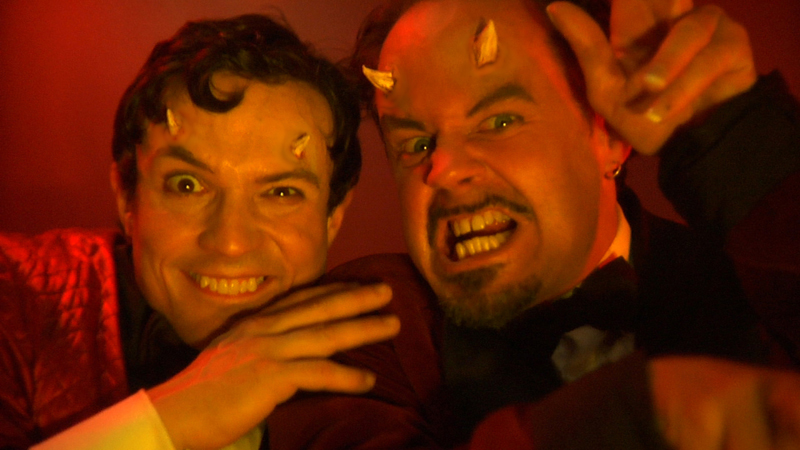 (segment D)
(segment D)
DIRECTED BY: Rodney Ascher, Julian Barratt, Robert Boocheck, Alejandro Brugués, Kristina Buozyte, Alexandre Bustillo, Larry Fessenden, Julian Gilbey, Jim Hosking, Lancelot Oduwa Imasuen, E.L. Katz, Aharon Keshales, Steven Kostanski, Marvin Kren, Juan Martínez Moreno, Erik Matti, Julien Maury, Robert Morgan, Chris Nash, Vincenzo Natali, Hajime Ohata, Navot Papushado, Bill Plympton, Dennison Ramalho, Todd Rohal, Jerome Sable, Bruno Samper, Jen Soska, Sylvia Soska, Sôichi Umezawa
FEATURING: Too many actors to list individually, and no one appears onscreen for long enough to qualify as “featured”
PLOT: 26 more short horror films about death, each inspired by an assigned letter of the alphabet.

WHY IT WON’T MAKE THE LIST: Only one out of these 26 films might qualify on its own merits as a candidate for the List of the Weirdest Movies Ever Made, which is not a favorable enough ratio to consider this anthology a contender.
COMMENTS: The original ABCs of Death was a somewhat successful reinvigoration of the horror anthology genre, benefiting from the novelty of the ultra-short short format. The sequel is more of the same, with a mostly second-tier (in terms of name recognition, not talent) slate of directors alphabetizing horror’s latest cemetery. One obvious improvement from the previous installment; there are hardly any toilet-themed scares here (the scat-horror fad thankfully played out in 2013). Fewer of the episodes qualify as astoundingly weird, but we’ll give you the rundown on what to watch out for.
First off, in the not-so-weird category, we have to mention neophyte director Rob Boochek’s “M is for Masticate,” winner of the fan-submission contest, whose entry (featuring a paunchy rampaging madman in stained underwear) amounts to a dumb and arguably dated joke—but one that made me laugh out loud at its perfectly-timed, abrupt punchline. Even better is Hajime Ohata’s “O is for Ochlocracy,” a clever Japanese entry which actually finds a new spin on the vastly overdone zomcom genre.
On to the weird scorecard. Todd Rohal‘s “P is for P-P-P Scary!,” is a tribute to early talkies, with three hillbilly Bowery Boys in absurd makeup and stereotypical striped prison garb cowering their way through a nameless void. It’s probably the most universally loathed segment of the film, and it’s easy to see why; Rohal’s highly personal and peculiar brand of awkward surreal comedy is an acquired taste that has yet to be acquired by almost anyone. It certainly won’t appeal to the average horror fan. The anthology ends with a weird, if relatively weak, flurry, with the action-figure inspired “W is for Wish,” the strange but inconsequential “X is for Xylophone” (which at least features Béatrice Dalle, ABC2‘s biggest star), the surreal special effects spectacle “Y is for Youth,” and the absurd pregnancy fable “Z is for Zygote.” There are a few other bizarre entries scattered about the alphabet. Kristina Buozyte and Bruno Samper’s “K is for Knell” is audiovisually apocalyptic but abstract and hard to connect with. Bill Plympton‘s much anticipated (by us) entry is quality, but nothing unexpected. Two scribbly lovers kiss each other to death, like a gorier version of one of his 1980s MTV shorts. “G is for Grandad” is an unclassifiable surprise tale of bizarre inter-generational rivalry from the previously unknown Jim Hosking. “Grandad” was noteworthy enough that the director parlayed this calling card into a feature film (titled The Greasy Strangler), to be released by cult-film specialist Drafthouse Films next year.
The most noteworthy episode—weird or not—is stop-motion specialist Robert Morgan‘s “D is for Deloused.” Technically impressive, it is also thoroughly surreal, taking place in a dirty lilac operating room full of bleeding men, scurrying cockroaches, and arm-sucking larvae with dual-headed clowns inside them. Nightmares don’t come much more terrifyingly irrational than this one, with a protagonist birthed from a corpse and commanded to “pay for life.” “Deloused” is the best thing in ABCs of Death 2, and it makes us long to see what the slow-working Morgan would do with a long-form project.
Overall, my judgment is that this sequel is less essential than the interesting-but-inessential original. Only Morgan’s segment rates as a must-catch for weirdophiles, while the first collection had three exceedingly bizarre entries to catch your eye. Overall, the uneven effect is about the same (although full disclosure requires me to report that most critics preferred this second installment, concluding that this crop of directors learned from the mistakes of their trailblazing predecessors).
Shion Sono and Alex de la Iglesia were announced as directors for this project, but pulled out before completing their shorts. There are currently no active plans for a third installment (the makers say that rampant piracy makes it difficult to recoup their investment).
WHAT THE CRITICS SAY:







